Pedestrian Crossovers
Pedestrian crossovers provide pedestrians with crossing opportunities by requiring motorists and cyclists to yield to pedestrians within the crosswalk. Drivers are legally required to stop regardless of whether or not the Pedestrian Crossover location has a flashing beacon.
Stopping at a Pedestrian Crossover helps protect lives. Failing to yield to a pedestrian on a Pedestrian Crossover carries a fine of up to $1,000 and 4 demerit points.
Pedestrian Crossover rules
Drivers
- Look for the signs and slow down.
- Be prepared to stop for pedestrians waiting to cross the road.
- Stop behind the yield line. This looks like shark teeth.
- Wait until the pedestrian completely crosses road.
- Look to make sure no one else is intending to cross the road before proceeding.
Never pass a vehicle that has stopped to allow pedestrians to cross the road.
Penalties
Learn the rules for pedestrian crossings and the penalties for endangering people on the road on Ontario.ca. Fines double in Community Safety Zones near schools and public areas, which are clearly marked with signs.
There are additional penalties for careless driving if pedestrians are put at risk.
Pedestrians
- Stand next to “stop for pedestrians” sign to indicate that you want to cross.
- If the Pedestrian Crossover has flashing beacons, press the button to activate the amber flasher.
- Cross only when traffic has come to a complete stop, or has enough time to stop before you begin to cross.
Cyclists
- Cyclists using the Pedestrian Crossover must dismount and walk the bike across the road.
- Cyclists approaching the Pedestrian Crossover must stop behind the yield line. This looks like shark teeth.
Types of pedestrian crossovers
Some Pedestrian Crossovers feature pavement markings on the ground, and "stop for pedestrian" signs on both sides of the road without flashing beacons. These are typically seen on low-traffic single lane roads or at single lane roundabouts. Examples of such crossings in London can be found at Hudson Dr at Frobisher Cres or Fairfax Crt at Limberlost Rd. Drivers are legally required to stop at all Pedestrian Crossover locations, with or without flashing beacons.
PEDESTRIAN CROSSOVER - TYPE C & B
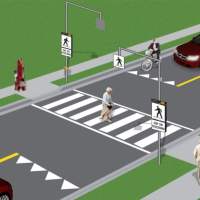
Some Pedestrian Crossovers include side-mounted ‘stop for pedestrian’ signs, pavement markings, and flashing beacons with push buttons that can be activated by pedestrians. In some cases, overhead signs are also added. These are commonly found on low to medium traffic volume single or multi-lane roadways. Examples of this type of crossing in London can be found at Dundas St and English St or Barker St at Grosvenor St. Drivers are legally required to stop at all Pedestrian Crossover locations, with or without flashing beacons.
How to recognize Pedestrian Crossovers
LOOK FOR SIGNS & PAVEMENT MARKINGS
Ladder crossing pavement markings, shown below, indicate where pedestrians are allowed to cross the road. They look like zebra stripes. The yield line, which looks like shark teeth, indicate where vehicles are required stop when a pedestrian is waiting to cross the road. All crossovers have drop curbs and tactile plates to help make crossing more accessible.
Drivers are legally required to stop regardless of whether or not the Pedestrian Crossover location has a flashing beacon.
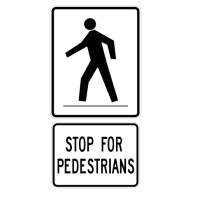
"Stop for Pedestrians” signs are located at all Pedestrian Crossover locations.
NO PASSING HERE TO CROSSING SIGNS
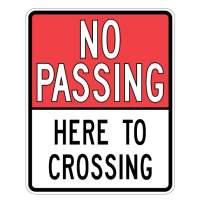
"No Passing Here To Crossing” signs are located 30m from the Pedestrian Crossover. Drivers cannot pass any vehicle within 30 metres of a Pedestrian Crossover.
PUSH BUTTON TO CROSS AT CROSSOVER SIGNS
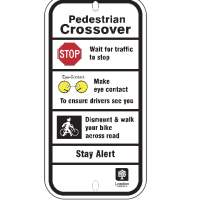
"Pedestrian Crossover” signs are located at Pedestrian Crossover locations that do not have flashing beacons (Type D). These signs provide instructions / important reminders to pedestrians using the crosswalk.
PEDESTRIAN CROSSOVER AHEAD SIGNS
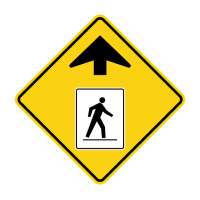
"Pedestrian Crossover Ahead” signs are located 50m to 130m from the Pedestrian Crossing to warn drivers.
Pedestrian crossovers at roundabouts
Pedestrian Crossovers were installed at the intersection of Southdale Road and Colonel Talbot Road as part of the improvements included in the roundabout project.
Tips for crossing the street at a roundabout:
- Use the designated crossings and sidewalks or multi-use paths.
- Travel around the outside, crossing one direction of vehicle traffic at a time, and pausing on the pedestrian islands in between.
- Always make sure drivers stop, or there is a gap in traffic, before you cross.
- If the crossing has a push button, press it to activate the flashing beacons.
- Make eye contact with any drivers approaching the crosswalk to ensure they’ve seen you.

Above location: Colonel Talbot and Southdale roundabout in London, Ontario.
Pedestrian crossover benefits
Pedestrian Crossovers have a number of benefits, including:
- Improved Safety: Pedestrian crossovers enhance safety by providing designated areas for pedestrians to cross roads. This helps reduce collisions involving pedestrians and drivers, as drivers are more likely to be aware of and yield to pedestrians in these marked areas.
- Accessibility: Pedestrian Crossovers make streets more accessible for individuals with disabilities, including those using wheelchairs, walkers, or other mobility aids. They feature curb cuts and tactile indicators to assist blind or low vision pedestrians in navigating safely.
- Encourages Walking and Active Transportation: By providing safe and convenient crossing points, pedestrian crossovers encourage walking and other forms of active transportation. This can contribute to improved personal health by promoting physical activity and reducing reliance on automobiles.
- Community Connectivity: Pedestrian Crossovers help connect different parts of a community, facilitating pedestrian access to schools, parks, businesses, public transportation, and other amenities. This fosters a sense of community and promotes social interaction.
- Traffic Calming: Pedestrian Crossovers can serve as a form of traffic calming by prompting drivers to slow down and be more cautious in areas with high pedestrian activity. This can help reduce vehicle speeds and create a safer environment for all road users.
- Environmental Benefits: Encouraging walking and active transportation through pedestrian crossovers can help reduce greenhouse gas emissions and air pollution associated with motor vehicle use. This aligns with sustainability goals and contributes to a healthier environment.
